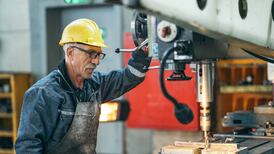The Republic's booming economy is continuing attract an influx of foreign workers, according to new figures from the Central Statistics Office (CSO).
The agency’s latest population statistics show that, of the 88,600 people who migrated here in the 12 months to April, two-thirds (61,700) were foreign nationals. The remainder were Irish nationals returning from abroad.
The CSO also released its latest Labour Force Survey – the official data source for employment – which shows a record 2.3 million people were employed in the Irish economy in the second quarter of 2019.
Speaking in Dublin about the figures, Minister for Finance Paschal Donohoe said they were ““very much in line” with the Government’s expectations of how the economy would perform.
He said Brexit was not yet impacting on employment figures but said there was a growing concern evident in consumer sentiment.
He added if the Government decided that in the coming weeks that a no-deal Brexit was the most likely outcome, it would inevitably have a bearing on the spending decisions that he would make in the forthcoming budget.
“The risk of a no-deal Brexit is growing. That risk will have a material effect on budgetary decisions that I will make,” he said.
The annual increase in employment in the three months to the end of June was 45,000 or 2 per cent. That represents a slight moderation on growth rates seen in previous quarters. Employment also decreased by 20,900 (0.9 per cent) over the previous quarter which analysts put down to a combination of slower construction growth, Brexit uncertainty and wider global trade concerns.
Nonetheless, it was the 28th consecutive quarter of annual employment growth since 2012, reflecting a remarkable turnaround in the State’s labour market since the low point of the crash.
While employment of Irish nationals grew by 1.6 per cent on an annual basis, employment among foreign nationals increased by 3.9 per cent. Foreign nationals now comprise a record 16.7 per cent of the workforce in the State.
The latest figures show employment increased in 11 of the 14 economic sectors with transport and storage, and education, exhibiting the biggest quarterly increases. Agriculture continues to be the weakest sector of the labour market with employment declining by 5.3 per cent year on year, the fifth consecutive annual decline, leaving employment in the sector at a record low.
Unemployment fell by 13,600 (9.4 per cent) in the year to the end of the second quarter. The headline rate of unemployment was, however, revised up to 5.3 per cent, which is significantly higher than the 4.6 per cent rate detailed in the CSO’s latest monthly numbers.
The CSO has made several high-profile revisions to the State's jobless rate in recent months. The agency's Edel Flannery acknowledged the revisions to unemployment were not ideal but insisted the agency was constrained by methodology. Either way the figures still point to a strong level of job creation and a corresponding slide in unemployment.
Despite the recovery in employment, the labour force participation rate is still below the rate achieved at the height of the boom in 2007 and actually fell by 0.2 per cent to 62.1 per cent in the year to end-June 2019.
Goodbody economist Dermot O’Leary highlighted the20,900 fall in employment on the previous quarter. “While one should not get carried away with one quarter, it does suggest that a combination of slower construction growth, Brexit uncertainty and wider global trade concerns is having some impact on the very open Irish economy,” he said.
KBC Bank economist Austin Hughes said the figures suggest a “healthy rather than hot economic climate”. He also said he expected employment growth to continue to slow in 2019 amid the current Brexit uncertainty.












